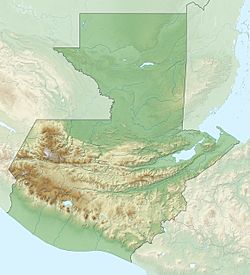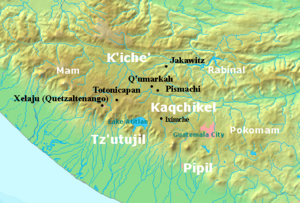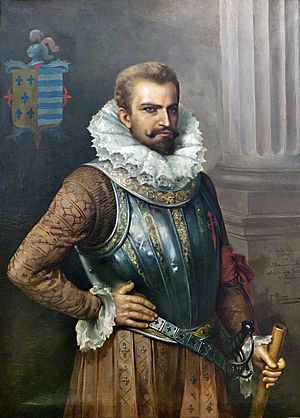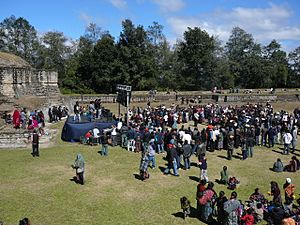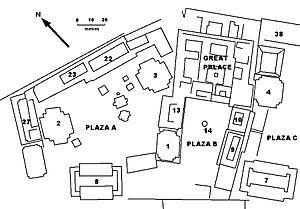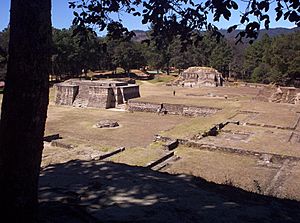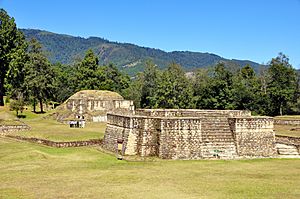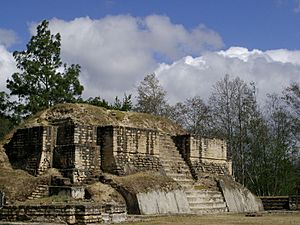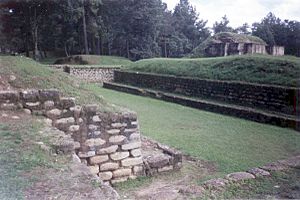Iximche facts for kids
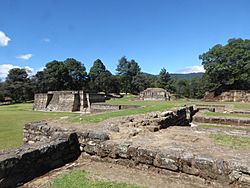 |
|
| Location | Tecpán Guatemala |
|---|---|
| Region | Chimaltenango Department, Guatemala |
| Coordinates | 14°44′8.88″N 90°59′46.32″W / 14.7358000°N 90.9962000°W |
| History | |
| Founded | 1470 |
| Abandoned | 1524 |
| Periods | Late Postclassic |
| Cultures | Kaqchikel Maya |
| Events | Conquered by: Spain |
| Site notes | |
| Archaeologists | Jorge Guillemín |
Iximche (pronounced "ee-sheem-CHEH") was an important ancient city in the western mountains of Guatemala. It was the capital city of the Kaqchikel Maya kingdom. This kingdom existed from about 1470 until 1524.
The city of Iximche had many amazing buildings. These included pyramid-temples, grand palaces, and two Mesoamerican ballcourts. When archaeologists dug here, they found old paintings on some buildings. They also found clear signs of human sacrifice.
In the 1960s, the ruins of Iximche were named a special National Monument in Guatemala. Today, you can visit the site. It has a small museum that shows off sculptures and pottery found there.
For many years, the Kaqchikel people were loyal friends of the Kʼicheʼ Maya. But as the Kaqchikel grew stronger, problems started. The Kaqchikel had to leave the Kʼicheʼ capital. They then built their own city, Iximche.
They chose a spot that was easy to defend. It was on a ridge almost completely surrounded by deep valleys. Iximche grew very fast. Within 50 years, it was as big as it would ever get. Four main lords from the Kaqchikel clans ruled the city. The lords from the Sotzʼil and Xahil clans held the most power.
After Iximche was built, the Kʼicheʼ left the Kaqchikel alone for a while. But the peace did not last. Around 1491, the Kaqchikel bravely defeated their former rulers. Then, there was fighting among the Kaqchikel clans themselves. The rebel clans were finally defeated in 1493. Wars against the Kʼicheʼ continued into the early 1500s.
When the Spanish conquistadors arrived in Mexico, the Aztec emperor sent warnings to the Kaqchikel. After the Aztecs lost to Hernán Cortés, Iximche sent its own messengers. They wanted to form an alliance with the Spanish. Sadly, smallpox spread through Iximche before the Europeans even arrived. It killed many people.
When the Spanish came, Iximche was the second most important city in the Guatemalan Highlands. The Kʼicheʼ capital, Qʼumarkaj, was the first. In 1524, the Spanish leader Pedro de Alvarado was welcomed in Iximche. The Kaqchikel kings gave the Spanish local allies. These allies helped conquer other Maya kingdoms in the highlands.
Iximche was even named the first capital of the Kingdom of Guatemala that same year. But the Spanish demanded too much gold. So, the Kaqchikel soon ended their alliance. They left their capital. Spanish soldiers who had left the army burned the city two years later. The Europeans started a new town nearby. But they left it in 1527 because the Kaqchikel kept fighting. The Kaqchikel finally gave up in 1530.
A Guatemalan historian first wrote about the ruins of Iximche in the late 1600s. Many scholars visited in the 1800s. They published maps and descriptions. Serious studies of the site began in the 1940s. They continued off and on until the early 1970s.
In 1980, during the Guatemalan Civil War, a meeting happened at the ruins. Guerilla fighters and Maya leaders met there. The guerillas said they would protect the rights of native people. In 1989, a special ceremony took place at the site. It was done to make the ruins a sacred place again for Maya ceremonies.
In 2007, United States President George W. Bush visited the site. That same year, Iximche hosted a big meeting. It was the Third Continental Summit of Indigenous Peoples.
Contents
What's in a Name?
The name Iximche comes from the Mayan language. It means "maize tree" (corn tree). This name refers to the ramon tree, which was important to them.
The Spanish called Iximche "Guatemala." This came from the Nahuatl word Quauhtemallan. It means "forested land." Since the Spanish made Iximche their first capital, they used this name for their new city. Over time, it became the name of the entire country.
Some old explorers in the 1800s also called the site Patinamit. This is a Kaqchikel word meaning "the city."
Where is Iximche?
Iximche is located about 3 kilometers (1.9 miles) south of Tecpán Guatemala. It is about 90 kilometers (56 miles) west of Guatemala City. You can find it in the northwest part of the Chimaltenango area of Guatemala.
The city was built high up, at about 2,260 meters (7,410 feet) above sea level. It was on a ridge that was easy to defend. This helped protect the city from its enemies, the Kʼicheʼ and Tzʼutujil.
The ridge is called Ratzamut. It is part of Tecpán hill, a tall mountain to the northwest. Two rivers flow in deep valleys on either side of the ridge. These rivers join and flow towards the Pacific Ocean. Iximche is surrounded by pine forests, which are common in the highlands of Guatemala.
How Iximche Was Ruled
The Kaqchikel kingdom was divided into four main groups, called clans. These clans were the Xahil, Sotzʼil, Tukuche, and Akajal.
Iximche was ruled by four main lords. Their titles were Ahpo Sotzʼil, Ahpo Xahil, Kʼalel Achi, and Ahuchan. But the Ahpo Sotzʼil and Ahpo Xahil were the most powerful. Each of these two main clans had a leader. The Sotzʼil king was usually seen as the senior or "firstborn" leader. The Xahil king was the "lastborn" or subordinate leader.
The titles of Ahpo Sotzʼil and Ahpo Xahil were passed down from father to son. The sons who would inherit these titles were also important military leaders.
When Iximche was founded, Wuqu-Batzʼ was the Ahpo Sotzʼil, and Hun-Toh was the Ahpo Xahil. The other two lords, Chuluk and Xitamel-Keh, were not as important. Each of the four lords had their own part of the city. This included their palace, royal court, and temples.
Important Leaders of Iximche
| Ahpo Sotzʼil | Ahpo Xahil | Kʼalel Achi | Ahuchan |
|---|---|---|---|
| Wuqu-Batzʼ | Hun-Toh | Chuluk | Xitamel-Keh |
| Oxlahuh-Tzʼiʼ | Lahuh-Ah | ||
| Kablahuh-Tihax | |||
| Hun-Iqʼ | Lahuh-Noh | ||
| Cahi Imox | Belehe Qat |
The Story of Iximche
Early Days
Archaeologists have found very few signs of people living here before the Kaqchikel. There were some ancient remains from the Late Preclassic period. A few items from the Classic Period have been found, but they don't show that a city existed here then.
The Kaqchikel Kingdom
The Kaqchikel people were closely related to the Kʼicheʼ. They had been allies for many years. The history of Iximche comes mostly from the Annals of the Kaqchikels. This book was written in the Kaqchikel language using Latin letters. It tells the story of the Kaqchikels, their origins, and their conquest.
Kaqchikel rulers Hun-Toh and Wuqu-Batzʼ were very loyal to the Kʼicheʼ king Kʼiqʼab. He rewarded them with royal titles and power. But Kʼiqʼab's sons became jealous of the Kaqchikel lords' growing power. They started a revolt against their father. This weakened the Kʼicheʼ king's power. It also allowed other conquered lands to break free.
A small event in the Kʼicheʼ capital, Qʼumarkaj, led to big changes. A Kʼicheʼ soldier tried to take bread from a Kaqchikel woman. She fought him off with a stick. The Kaqchikel wanted the soldier punished. The Kʼicheʼ wanted the woman punished. When the Kaqchikel lords refused to hand her over, the Kʼicheʼ lords sentenced Hun-Toh and Wuqu-Batzʼ to death.
King Kʼiqʼab secretly warned his Kaqchikel friends. He told them to flee Qʼumarkaj. On a day called 13 Iqʼ in the Kaqchikel calendar, the four Kaqchikel lords led their people away. They went to build their own capital at Iximche. This happened between 1470 and 1485. The Kaqchikel left their old capital because it was too close to Qʼumarkaj.
King Kʼiqʼab stopped his nobles from attacking the Kaqchikel. This gave his former allies time to build their new kingdom and its defenses. When Hun-Toh died, his son Lahuh-Ah took over. Oxlahuh-Tzʼiʼ, the son of Wuqu-Batzʼ, ruled for a long time and was very successful.
The Kaqchikel kings Oxlahuh-Tzʼiʼ and Kablahuh-Tihax won a big victory over the Kʼicheʼ around 1491. They captured the Kʼicheʼ kings Tepepul and Itzayul. They also captured the idol of their most important god, Tohil. The captured Kʼicheʼ kings and many nobles were sacrificed.
After this victory, two Kaqchikel clans, the Akahal and Tukuche, rebelled. But kings Oxlahuh-Tzʼiʼ and Kablahuh-Tihax quickly crushed the rebellion on May 20, 1493.
Oxlahuh-Tzʼiʼ died on July 23, 1508. His son Hun-Iqʼ became king. Kablahuh-Tihax died on February 4, 1509. His son Lahuh-Noh took his place. The Kaqchikel continued fighting the Kʼicheʼ kingdom for the next ten years.
In 1510, the Aztec emperor Moctezuma II sent messages to the Kaqchikel. He warned them about strangers in the Caribbean Sea. In 1512, he sent another messenger. This messenger warned them about the Spanish arriving in Yucatán and Veracruz.
In 1513, Iximche suffered from a plague of locusts. The next year, in 1514, a fire badly damaged the city. A terrible plague hit the city in 1519 and lasted two years. Many people died. This was probably smallpox, brought to the Americas by the Spanish.
After the Aztec capital Tenochtitlan fell to the Spanish in 1521, the Kaqchikel sent messengers to Hernán Cortés. They offered to become allies with the Spanish.
On August 11, 1521, Belehe Qat and Cahi Imox became the new lords of the city. This happened after the deaths of the previous kings, Hun-Iqʼ and Lahuh-Noh. Cahi Imox was the Ahpo Sotzʼil, and Belehe Qat was the Ahpo Xahil. Just before the Spanish arrived, the Kaqchikel kingdom was growing. It was becoming the most powerful new kingdom in the Guatemalan Highlands. It was second only to the Kʼicheʼ capital at Qʼumarkaj.
The Spanish Arrive
When Spanish conquistador Pedro de Alvarado arrived in what is now Guatemala in 1524, the Maya kingdoms were weak. They had been fighting for twenty years and were suffering from European diseases. From February to March 1524, Alvarado fought and defeated the Kʼicheʼ. He destroyed Qʼumarkaj and executed the Kʼicheʼ kings.
The Spanish were invited into Iximche on April 14, 1524. The lords Belehe Qat and Cahi Imox welcomed them. The Kaqchikel kings gave the Spanish native soldiers. These soldiers helped the Spanish fight the Kʼicheʼ and defeat the nearby Tzʼutuhil kingdom.
The Spanish stayed only a short time in Iximche. They then continued their journey. They returned to the Kaqchikel capital on July 23, 1524. On July 27, Pedro de Alvarado declared Iximche the first capital of Guatemala. He named it Santiago de los Caballeros de Guatemala.
Pedro de Alvarado quickly started demanding gold from the Kaqchikels. This ruined the friendship between them. He demanded 1000 gold leaves, each weighing 15 pesos. A Kaqchikel priest said that their gods would destroy the Spanish. So, the Kaqchikel people left their city. They fled to the forests and hills on August 28, 1524. Ten days later, the Spanish declared war on the Kaqchikel.
A few years later, on February 9, 1526, a group of sixteen Spanish soldiers who had left the army burned the palace of the Ahpo Xahil. They robbed the temples and kidnapped a priest. The Kaqchikel blamed Pedro de Alvarado for these actions.
The Spanish writer Bernal Díaz del Castillo said that in 1526, he returned to Iximche. He spent the night in the "old city of Guatemala." He wrote that the city's houses were still in great condition. His account was the last time the city was described while people still lived there.
The Spanish started a new town called Tecpán Guatemala. The name "Tecpán" means "palace" in Nahuatl. So, the new town's name meant "the palace among the trees." The people of Iximche were spread out. Some moved to Tecpán, others to Sololá, and other towns around Lake Atitlán.
The Spanish left Tecpán in 1527. This was because the Kaqchikel kept attacking them. They moved their capital to the Almolonga Valley, near Antigua Guatemala.
The Kaqchikel kept fighting the Spanish for several years. But on May 9, 1530, the two kings of the most important clans returned from hiding. The next day, many nobles and their families joined them. Many more people came to surrender at the new Spanish capital.
Iximche Today
A Guatemalan historian named Francisco Antonio de Fuentes y Guzmán first wrote about the ruins in 1695. In 1834, Miguel Rivera Maestre published some maps and drawings of the ruins. American writer John Lloyd Stephens visited Iximche in 1840. He called the ruins Patinamit. He said that local people had taken stones from the site for many years to build things in Tecpán.
In the past, people from Tecpán would visit the ruins every Good Friday for a special ceremony. This tradition stopped by the late 1900s.
Alfred P. Maudslay visited Iximche in 1887. He made a survey of the site and published a map. Serious archaeological digs began in 1956. Swiss-Guatemalan archaeologist George (Jorge) Guillemín excavated the city from 1959 to 1972. He published some of his findings. He died before finishing his full report. His notes were finally published in 2003.
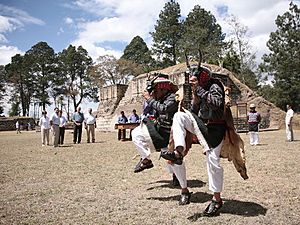
In 1960, the ruins of Iximche were officially declared a National Monument. In 1980, during the Guatemalan Civil War, Maya leaders and guerilla fighters met at the ruins. They signed the "Declaration of Iximche." In this declaration, the guerillas promised to defend the rights of native people. In 1989, an important Maya ceremony was held at the site. This was to make the ruins a sacred place again for native ceremonies.
United States President George W. Bush visited the site on March 12, 2007. Local Maya priests said they would perform cleansing rituals after his visit. They wanted to remove any "bad spirits" brought by the president. They said he had treated their "migrant brothers" badly in the United States. A spokesman said, "We don't want our people to be seen as just a tourist attraction."
From March 26 to 30, 2007, Iximche hosted a big meeting. It was the Third Continental Summit of Indigenous Peoples. The meeting ended with the "Declaration of Iximche." This declaration committed the delegates to fight for fairness and against unfair systems.
Visiting Iximche
Most visitors to Iximche are Maya people from the area. On weekends, about 250 people visit each day. Not many international tourists visit the ruins. Most visitors are Guatemalan citizens. Modern aj qʼijab' (Maya priests) come to Iximche as pilgrims. They travel from all over the Guatemalan Highlands.
The site has things for visitors like parking, a small museum, a picnic area, and a football field. The museum is open every day. It shows many objects found at the ruins.
What the Site Looks Like
The Spanish largely kept the site safe because they were allies with the Kaqchikel. The main part of the city is surrounded by deep valleys. A defensive ditch separates it from the living areas. The city grew very fast. Within 50 years, it reached its largest size. This quick growth meant that people started living even on the edges of the valleys.
The center of the city has four large and two smaller plazas (open squares). Each plaza had at least two temples. There were also elite palaces and two ballcourts. The larger ballcourt was 40 meters (130 feet) long. The plazas are named A, B, C, D, E, and F, from northwest to southeast. A wall separated the ceremonial center from the residential areas.
Today, you enter the ruins through the modern town of Tecpán Guatemala. This town was built after Iximche was destroyed. The entrance to the site is on the north side. It has parking, a small museum, a picnic area, and a football field.
To the south of the ruins, there is a modern ceremonial area. Modern Kaqchikel people use it for their rituals. A path connects this area to the ruins. It has six concrete altars around an unexcavated building. People place flowers, food, and drinks on these altars as offerings. The museum displays sculptures and pottery found at the site.
Plazas A and B were likely part of a single complex for the Sotzʼil clan. This included the palace of the Ahpo Sotzʼil. Plaza A has a ballcourt, two temples, and ten palace buildings. Five of these buildings are connected.
Plaza C was separated from Plazas A and B by a 3-meter (9.8-foot) wall. This was the palace area of the Ahpo Xahil, the junior co-ruler. Plaza C also had two temples facing each other. The Xahil ballcourt was on the southwest side of Plaza C. The Ahpo Xahil palace was on the southeast side.
The Xahil Palace was built facing east-west. It had an entry courtyard on the west side and a central altar. The main palace was entered from the east side of this courtyard. The rooms and courtyards of the Xahil Palace had many everyday items. A large fire destroyed the Xahil Palace. Its adobe walls collapsed. This might be where Pedro de Alvarado stayed with his Spanish soldiers. It could also be the building that Spanish soldiers burned in 1526. The collapse of the building saved many items for archaeologists. This was different from the Ahpo Sotzʼil palace, where few items were found.
Plaza D has not been fully dug up. But archaeologists have cleared and mapped it. It is a large plaza surrounded by high mounds. It doesn't seem to have had the large pyramids like the other main plazas. It had a palace on the south side with three inner courtyards. The westernmost courtyard had a cross-shaped altar. This palace was smaller than the others. It is believed to have been the palace of the Ahuchan.
Plazas E and F are to the east of Plaza D. They also had palace buildings. These plazas were not mapped by Guillemín and are still covered by trees. These two plazas formed one complex. It is thought to have belonged to the Kʼalel Achi.
The defensive ditch across the promontory was originally 8 meters (26 feet) deep. It was mostly filled in soon after the Spanish Conquest. This made the city less defensible. In the mid-1800s, the ditch was 3 yards (2.7 meters) deep. In the 1960s, you could still see it, but now it is almost completely filled in.
Archaeologists found many ceramic items. These included incense-burners with handles and decorations. The most common pottery for daily use was a shiny type. It included ceramic comals (flat griddles). Imported pottery was also found. This included Chinautla Polychrome and White-on-red styles. Brown bowls were also found, similar to those in Zaculeu and Mixco Viejo. These cities were also active in the Late Postclassic period.
Three-legged metates (grinding stones) were often found. Many black obsidian blades were also discovered. Simple jade jewelry was found too. Evidence of human sacrifice was also present at the site.
Because the Spanish only stayed for a short time, very few European items were found. The few pieces found were iron crossbow bolts.
Buildings of Iximche
More than 160 buildings have been mapped at Iximche. The buildings were covered with stone blocks. These blocks were coated in lime plaster. Some were then painted with Mixtec-Puebla style murals. But only a few traces of these paintings remain today. This style of painting started around AD 900 in central Mexico. It then spread throughout Mesoamerica.
The upper parts of the buildings were made from adobe blocks. They once had roofs made of beams and mortar, but these have not survived. The bases of the platforms were usually built from rough stones set in clay. Some of the buildings have been restored. The main part of the site is kept clear of plants. Houses built on platforms around the ceremonial plazas usually had built-in benches and fireplaces.
Great Palace I
The Great Palace I is a large living area on the northeast side of Plaza B. What remains are a sunken patio and some low house platforms. Digs showed three building phases. The earliest phase dates to when the city was founded by Wuqu-Batzʼ and Hun-Toh. This phase covered about 500 square meters (5,400 sq ft). It became the center of the palace.
The first phase had four long, single-room buildings around a courtyard. The courtyard had an altar in the middle. The living units had benches against the walls and fireplaces in the middle of the floor. The walls were originally adobe, covered with painted murals. Items found from this phase included obsidian knives, comals, metates, and pottery. Pieces of incense burners were found near the altars.
The palace grew in all directions. New buildings and courtyards were added. The early courtyard was later divided into smaller patios. The last building phase dates to the rule of Hun-Iqʼ and Lajuj Noj. By then, the palace covered over 3,000 square meters (32,000 sq ft).
On the southwest of the palace courtyard were low platforms. These might have been for ritual dances. On the southeast side was a building with benches on three walls and fireplaces at each end. This might have been the room where the Ahpo Sotzʼil met visitors and received tributes.
Great Palace II
The Great Palace II is another large living area. It is on the southeast side of Plaza C. The palace has many small rooms around seven inner courtyards. Many pieces of pottery were found inside this palace.
The rooms around the northeast courtyard in Great Palace II might have been the royal apartments. This is because of their location near the central courtyard. They were also closed off from it. The pottery from this area was special and from other places. This suggests it belonged to important people. The royal apartments might also have included the rooms around the north courtyard.
Temple 2
Temple 2 (also called Structure 2) is a stepped pyramid on the west side of Plaza A. It has stairs on the east side, leading up from the plaza. Structure 2 faces the sunrise on the summer solstice. It is the best-preserved temple that has been dug up.
Like many buildings at Iximche, it was built in three stages. The oldest stage dates to the reigns of Wuqu-Batzʼ, Oxlahuh Tzʼiʼ, and Hun-Iqʼ. The earliest stage is not well preserved. Its stones were taken to be reused. The middle stage is the best preserved. It had four stepped levels. These supported tall walls with a sloping base and a vertical panel on top. The temple had recessed corners. A steep stairway led to the top level. At the top of the stairs was a 40-centimeter (16-inch) high altar. It was 45 centimeters (18 inches) wide and 18 centimeters (7.1 inches) deep. The altar was made of stone and stucco. Its top was slightly curved. This type of altar was used for human sacrifice.
The temple floor is 9 meters (30 feet) above the plaza. The temple building, including its walls and roof, would have added another 5 meters (16 feet) to its total height. This was at the time of the Spanish Conquest. The temple shrine had benches built into three sides of its interior. It also had a fireplace in the middle. A small back room also had benches. This room might have been where the gods of the Sotzʼil were kept.
A small part of the temple floor had been opened, as if for a burial. But the tomb was never used and was covered again. The remains of a turtle were found in the plaza in front of the temple. This turtle might have represented one of the bacabs, mythical beings that supported the temple. Turtles were also important in Maya myths about the Maize God.
The temple shrine was built on a final platform on top of the fourth level. The parts of the shrine that are visible today date to the reign of Oxlahuh-Tzʼiʼ. It had three doorways separated by columns. It was built from adobe covered with plaster. The columns and walls next to the doorways were painted. Archaeologists found traces of red, yellow, and blue colors. These colors were put on designs carved into a thin layer of clay. The artwork was very fine. It showed that a skilled artist made it.
There were ten painted figures on the front of the building. More paintings were on the back. The designs had two rows of circles above a row of vertical stripes. Figures were painted against the striped background, with the circles above them. The painted figures are doing different things, like piercing their tongues. They probably show a Kaqchikel ritual happening. The paintings are not well preserved. This is due to dampness and damage from tree roots. The style of the paintings is very similar to Postclassic Mixtec art.
At the southwest corner of Temple 2 is a low platform. It had painted murals of a skull with crossed bones. This platform might have been an itzompan, or "skull place." This was a Kaqchikel version of the Aztec tzompantli skull racks. Two skulls showing signs of decapitation were found near Temple 2. They were found with some obsidian blades.
Temple 3
Temple 3 (also known as Structure 3) is a pyramid-temple on the east side of Plaza A. It is across from Temple 2 and looks similar. The stairs go up the west side of the temple platform. In front of the stairs, at plaza level, is a small rectangular platform.
Many ceramic pieces were found with this building. These were parts of large, round incense-burners. More than twelve were used in the temple. One showed an old god coming out of a serpent's mouth. Two others showed the same god standing. They might represent one of the Kaqchikel gods, Bʼelehe-Toh or Hun-Tihax. The incense burners were found exactly where the Kaqchikels left them when they left Iximche. Some of these burners had a hanging sun disc with rays.
Pieces of an Early Postclassic plumbate ware vessel were found around three sides of the temple. These were probably parts of a sacred item from inside the temple. There is no sign of early settlement at Iximche. So, this item might have been taken from Zaculeu. Zaculeu was a city with a long history that the Kʼicheʼ-Kaqchikel alliance conquered. A sacrificial flint knife was also found in Structure 3. Two low platforms stand in front of the temple. They were likely used as altars or dance platforms.
Other Buildings
Structure 1 (also called Temple 1) is a pyramid temple facing Plaza B. It is the only temple at Iximche that has been fully restored.
Structure 4 is another pyramid-temple base on the west side of Plaza C. It has a low platform at its southeast corner. Here, 48 severed heads were found just to the west. Some scholars think these might be the heads of the Kʼicheʼ kings Tepupul and Itzayul. They were captured and beheaded by the Kaqchikels. Most of the skulls were found with obsidian blades. Most skulls were buried alone in pits in the plaza floor. A few were grouped together.
Structure 5 was a pyramid-temple. Digs showed at least two building phases. The pyramid platform had one stair that split into two as it reached the top shrine.
Structure 6 is a temple-pyramid platform that has not been restored. It is southwest of Plaza C.
Structure 7, on the southwest side of Plaza C, is a ballcourt. It is similar in size to Structure 8. This was the ballcourt of the Xahil clan. It might have been the older of the two ballcourts. Each end of the ballcourt had stairs. There were also extra stairs to the southeast. A carved head found in Plaza C might have been a ballcourt marker from this court.
Structure 8 is on the southwest side of Plaza A. It is a 40-meter (130-foot) long I-shaped ball-court. The playing area is 30 by 7 meters (98 by 23 feet). The end-zones are closed off and reached by stairs. The two side platforms around the playing area were made larger. In Kaqchikel, ballcourts were called hom. They were seen as entrances to Xibalba, the underworld. Structure 8 has been dug up and restored. Digs found two layers of plaster flooring. This shows that the ballcourt was built during the second of the three main building phases at Iximche, around AD 1500.
Structure 9-sub had two pillars that separated three doorways.
Structure 10 had an inner patio. The building surrounded it on three sides.
Structure 13, between Plazas A and B, had an inner patio. The building surrounded it on three sides, much like Structure 10.
Structure 14 is a round altar in Plaza B. It is 3.5 meters (11 feet) across. It is very similar to altars used for "gladiatorial sacrifice" by the Aztecs. It might have been used for this purpose. This idea is supported by a noble burial found with three other people.
Structure 22 is a long building on the north side of Plaza A. The bases of pillars remain. These pillars once separated five doorways. Structure 22 is one of the best-preserved palace platforms at Iximche. It had benches inside three of the walls and fireplaces in the floor.
Structure 24 - Two rough, carved animal heads were found near this structure. They were probably jaguar heads. They might have been ballcourt markers from one of the two ballcourts. They likely had stucco added to them.
Structure 27 is behind Temple 2. A noble tomb, E-27-A, was found inside it.
Structure 38 is a 200-foot (61-meter) long platform. It completely enclosed the north side of Plaza C. It supported three houses. Each house had its own stairway. Everyday pottery was found with these buildings. An incense burner with a figure of Tlaloc, the central Mexican rain god, was also found.
Human Remains and Discoveries
Archaeologists have found the bones of over 100 people at Iximche. Some were very well preserved. Unfortunately, the bones got mixed up after being stored. So, their original locations are not clear anymore.
Thirty-six skulls were studied. Of these, 25 showed signs of decapitation (beheading). This was a common sacrificial practice in Maya art. Thirteen of these sacrifices were male, seven were female, and five were of unknown gender. Most were young adults. Ten were between 15 and 21 years old. Eleven were just over 21 years old. These sacrificed people were probably not Kaqchikels. They were likely captives from enemy groups.
Less than 3% of the skulls showed signs of iron deficiency anemia. This is a very low number compared to other sites. This suggests that these people did not have poor diets. They were likely from the elite class. 31% of the skulls showed signs of infection. About half of these were active infections at the time of death. This suggests a high level of airborne germs in the environment.
Tooth analysis was done on 19 people. It showed hypoplasia (problems with tooth enamel) in 89% of them. This means many had poor health in their first 7 years of childhood.
All tombs found were burials under houses. The bodies were found in a squatting position without any special direction. Many bodies were found with a broken obsidian blade. Some burials had other offerings. For example, a woman was buried with cooking tools, some blackened with soot. Two child burials each had a jade bead. The burial of an elderly man had pieces of burnt pine and evergreen oak.
Burial E-27-A was a noble tomb in Structure 27, in Plaza A. The bones of three sacrificed adults were piled face down in a 1-square-meter (11 sq ft) space. Underneath these sacrifices were the seated remains of another person. This person wore a gold headband with jade and turquoise mosaic. They also had a necklace with ten jaguar heads and forty small gold beads. On each arm, they wore a bracelet made from a human skull bone. It was carved with fine designs of birds and stars. A beautiful piece of jade was found near the lower jaw. It was probably placed in the person's mouth. There was also a copper nose ornament shaped like the moon. Some jade beads were found too. One bead looked like a god similar to those on the incense burners at Temple 3.
These remains were from the earlier period of Iximche. The person had died in battle from a blow to the head. This burial is thought to be one of two sons of Wuqu-Batzʼ of the Xahil clan. They died in the Kaqchikel wars of expansion. Their names were Chopena-Tzʼiʼkin Uka or Chopena-Tohin.
Images for kids
 In Spanish: Iximché para niños
In Spanish: Iximché para niños


